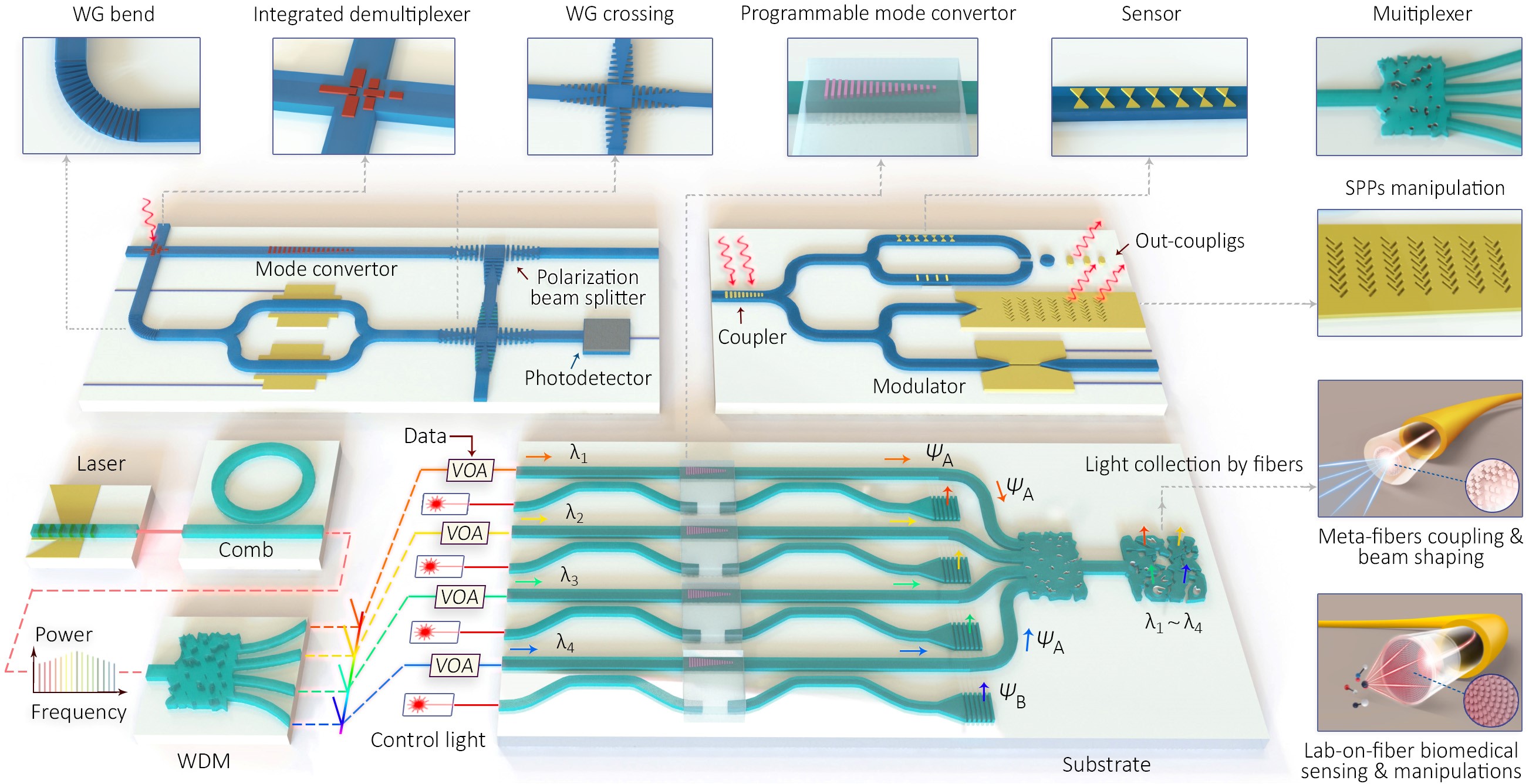Recent years have witnessed tremendous interest in synergizing various functional subwavelength structures into diverse optical waveguide platforms to enable versatile photonic meta-devices. The advancement of meta-waveguides not only extends meta-optics into the manipulation of guided wave, but may also reshape the landscapes of photonic integrated circuits and massive emergent applications. A recent review paper outlined latest progress on meta-waveguides-based photonics devices and systems. Both forward and inverse designed scenarios are cataloged showcasing vibrant opportunities.
- Metamaterials
- Photonic integrated circuits
- Metasurface
- Plasmonics
- Optical fibers
- Inverse design
1. Introduction
Comprised of judiciously engineered microscopic photonic structures with subwavelength features, the concept of metasurface and metamaterials have proven fruitful results. Previous research attentions are mainly devoted to applying meta-structures to tailor light in free space and develop relevant devices and applications. However, recent researches are revealing the prominent potential of leveraging subwavelength meta-structured waveguides to enable exotic waveguiding phenomena and design novel waveguide-based optical devices.
For instance, photonic integrated circuits are hatching as a promising candidate to revolutionize conventional integrated electronic circuits for its exceptional advantages such as broad bandwidth, high operation speed, and low power consumption. Nevertheless, as the most fundamental building block of integrated photonics, conventional optical waveguides still encounter challenges in terms of bulk footprint, compromised light-matter interaction efficiency, and restrained available functionalities. Fortunately, the concept of meta-waveguides can be adopted here to open a new avenue towards powerful manipulation of guided light in subwavelength scale, infusing new degrees of freedom into waveguide landscapes to dramatically boost device performance and enable novel functionalities.
In a new paper published on the journal of ‘Light: Science & Applications’, a team of scientists from China, United States and Italy have presented a comprehensive review article offering a panorama on the optic of meta-waveguides[1]. Latest advances on various subwavelength meta-structured waveguides are systematically cataloged, encompassing a broad class of photonic devices and systems that ally metamaterials and metasurfaces with diverse optical waveguides (dielectric/ plasmonic/ optical fibers)[2][3][4][5]. Brief physical fundamentals with explicit design methods (including both forward and inverse design tutorials) and representative applications for meta-waveguides are comprehensively summarized. The authors highlighted “how incorporating the concepts of meta-optics with waveguide technologies can propel photonic integrated circuits into new heights, by providing versatile efficient coupling interfaces, novel on-chip optical signal processing paradigms and diverse platforms for sensing, imaging and artificial intelligence”.
2. Applications
A plethora of applications are prototyped on this flexible playground, including, for instance, metasurface-patterned dielectric waveguides, forward designed metamaterial waveguides, metasurface- or metamaterial-hybrid optical fibers, meta-structures- assisted plasmonic waveguides, and inverse designed metamaterial waveguides, to name a few[6][7][8][9].

As illustrated in Figure 1a, meta-waveguides can be classified via either design methods or underpinning waveguide platforms.
“On the one hand, meta-waveguides can be conceived by physical intuition-based approaches (namely forward design henceforth) by leveraging the toolbox of metasurfaces and metamaterials with waveguide optics.”
“On the other hand, we can also use inverse design, which relies on computer optimizations (see Figure 1b), to develop free-formed analog (curvilinear boundaries) or digital (with relatively regular boundaries) metamaterial waveguides.”
Photonic structures with subwavelength details are canonical to meta-waveguides. Taking two-dimensional periodic silicon segments as an instance, the meta-waveguides should be modeled as a designer effective medium, which is different from the photonic bandgap theory found in photonic crystals or scalar diffraction theory used in non-subwavelength gratings.
“Despite the concept of meta-waveguides is still in its infancy, exciting progress are hatching with bright perspectives and profound potential applications. As conceptually illustrated in Figure 2, the advancement of meta-waveguides can not only extend meta-optics to the realm of guided electromagnetic waves and waveguide technology, but also promise to reshape the landscapes of photonic integrated circuits and massive emergent applications,” as the scientists envisaged.

Meta-waveguides may further venture photonic integrated circuits and many relevant applications in biomedical sensing, imaging, and detection into new territories. Massive novel emerging device functions will still await exploring in this vibrant field.
More Thinfo: See the papers entry is adapted https://www.nature.com/articles/s41377-021-00655-x.
Afrticle DOI:om 10.1038/s41377-021-00655-x
References
- Yuan Meng; Yizhen Chen; Longhui Lu; Yimin Ding; Andrea Cusano; Jonathan A. Fan; Qiaomu Hu; KaiYuan Wang; Zhenwei Xie; Zhoutian Liu; et al.Yuanmu YangQiang LiuMali GongQirong XiaoShulin SunMinming ZhangXiaocong YuanXingjie Ni Optical meta-waveguides for integrated photonics and beyond. Light: Science & Applications 2021, 10, 1-44, 10.1038/s41377-021-00655-x.
- Xuexue Guo; Yimin Ding; Xi Chen; Yao Duan; Xingjie Ni; Molding free-space light with guided wave–driven metasurfaces. Science Advances 2020, 6, eabb4142, 10.1126/sciadv.abb4142.
- KaiYuan Wang; Xinshu Ren; Weijie Chang; Longhui Lu; Deming Liu; Minming Zhang; Inverse design of digital nanophotonic devices using the adjoint method. Photonics Research 2020, 8, 528, 10.1364/prj.383887.
- Yuan Meng; Zhoutian Liu; Zhenwei Xie; Ride Wang; Tiancheng Qi; Futai Hu; Hyunseok Kim; Qirong Xiao; Xing Fu; Qiang Wu; et al.Sang-Hoon BaeMali GongXiaocong Yuan Versatile on-chip light coupling and (de)multiplexing from arbitrary polarizations to controlled waveguide modes using an integrated dielectric metasurface. Photonics Research 2020, 8, 564, 10.1364/prj.384449.
- Maria Principe; Marco Consales; Alberto Micco; Alessio Crescitelli; Giuseppe Castaldi; Emanuela Esposito; Vera La Ferrara; Antonello Cutolo; Vincenzo Galdi; Andrea Cusano; et al. Optical fiber meta-tips. Light: Science & Applications 2016, 6, e16226-e16226, 10.1038/lsa.2016.226.
- Pavel Cheben; Robert Halir; Jens H. Schmid; Harry A. Atwater; David R. Smith; Subwavelength integrated photonics. Nature 2018, 560, 565-572, 10.1038/s41586-018-0421-7.
- Shulin Sun; Qiong He; Jiaming Hao; Shiyi Xiao; Lei Zhou; Electromagnetic metasurfaces: physics and applications. Advances in Optics and Photonics 2019, 11, 380-479, 10.1364/aop.11.000380.
- Zhenwei Xie; Ting Lei; Fan Li; Haodong Qiu; Zecen Zhang; Hong Wang; Changjun Min; Luping Du; Zhaohui Li; Xiaocong Yuan; et al. Ultra-broadband on-chip twisted light emitter for optical communications. Light: Science & Applications 2018, 7, 18001-18001, 10.1038/lsa.2018.1.
- Zhaoyi Li; Myoung-Hwan Kim; Cheng Wang; Zhaohong Han; Sajan Shrestha; Adam Christopher Overvig; Ming Lu; Aaron Stein; Anuradha Murthy Agarwal; Marko Lončar; et al.Nanfang Yu Controlling propagation and coupling of waveguide modes using phase-gradient metasurfaces. Nature Nanotechnology 2017, 12, 675-683, 10.1038/nnano.2017.50.
